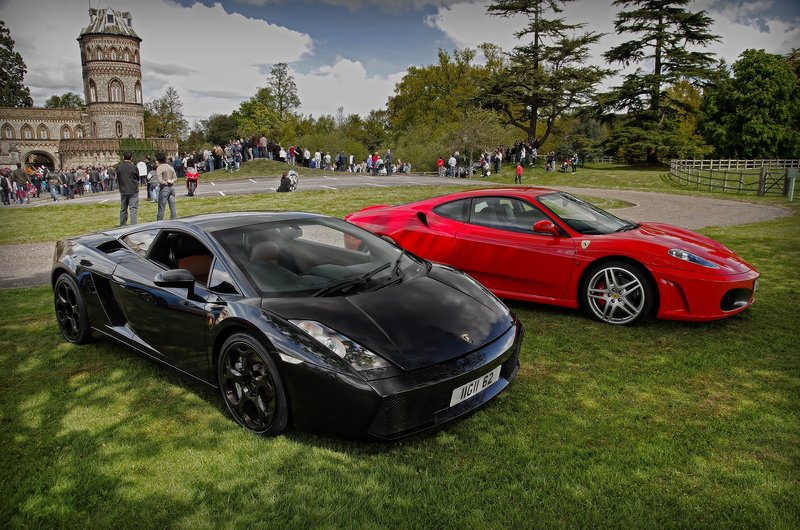K30 jpg very poor
I tried fiddling around but made things worse and then missed a chance to shoot the car i had been waiting for. You know how it is, once things go wrong they quickly get far worse as you panic to recover the situation. In the end i gave up and reset the camera, put it into full auto so i at least had some photos to show for the day.
I think i need to learn how to set custom WB on the fly. And do quickly and efficiently. It was total user error today to be honest. Camera struggling with bright sunlight and lots of bright red cars and the user behind the camera didn't have the skill set to adapt.....
F1

Pantera

The Pantera was taken in full auto as i tried to capture something of the day to show my son but the camera was all at sea. It almost looks like some bloomin effect...
I did manage to have a play in Elements and tone things down with this image:

Solutions? Better exposure control - I use -0.5EV routinely, Daylight WB and Natural. That seems to do the trick.

Stockport 5 Tram by kh1234567890, on Flickr
“We must avoid however, snapping away, shooting quickly and without thought, overloading ourselves with unnecessary images that clutter our memory and diminish the clarity of the whole.” - Henri Cartier-Bresson -
The car in the second shot and the sky in the third are the worst parts. It looks like over-processing to me. If you were set on Natural and the WB was even AWB these shouldn't be that severe. The grass is good, so exposure in the shadows is OK, so maybe there's been some over-exposure as well. The brightest areas do look clipped.
Solutions? Better exposure control - I use -0.5EV routinely, Daylight WB and Natural. That seems to do the trick.
First and second photos were straight from the camera, no processing. I think you are right, will routinely reduce the EV compensation.
I would reset everything back to factory defaults and see what happens
Thanks Ken, now done.
Shoot RAW or RAW+ next time. Pentax is usually not too bad at capturing reds
Definitely the answer. Would normally have shot using RAW but left the 16Gb SD card in the PC, so had to use a 2Gb card. RAW and a couple of movies would have eaten the card in no time. So kept to JPG.
Will have a play around tonight now the camera is reset. Strange thing, in 4 years of owning the K10D i never once had a problem with colours, RAW or JPG. Never crossed my mind. Hopefully all sorted now the camera is reset.
The output JPEG represents a file compression and bit depth reduction down to 8 bit (from 12 or 14 bit data created by the sensor which is then simply deleted from the camera memory). Its true that eventually in any workflow we will probably end up creating an 8 bit jpeg, but that is after the opportunity to carry out all the key, quality-critical adjustments on a RAW file or 16bit TIFF, retaining all the extra editing latitude and smooth toning possibilities that allows.
I know RAW processing is not something that everyone wants to get into - but the reality IMO is that if you have any interest in using your camera at its potential and seeing what it has been designed to do, then you have no choice.
Just take a close look at some fine detail from a camera output JPEG (or camera processed 8bit TIFF) and compare to the same image from RAW with basic conversion parameters applied, then output to 16 bit TIFF. I have seen on the 8 bit files some very nasty things!
Pentax K7 with BG-4 Grip / Samyang 14mm f2.8 ED AS IF UMC / DA18-55mm f3.5-5.6 AL WR / SMC A28mm f2.8 / D FA 28-105mm / SMC F35-70 f3.5-4.5 / SMC A50mm f1.7 / Tamron AF70-300mm f4-5.6 Di LD macro / SMC M75-150mm f4.0 / Tamron Adaptall (CT-135) 135mm f2.8 / Asahi Takumar-A 2X tele-converter / Pentax AF-540FGZ (I & II) Flashes / Cactus RF60/X Flashes & V6/V6II Transceiver
Following McGregNi's comment - try comparing the highest quality (lowest compression), full pixel JPG from the camera against one created on the PC.
Or take a low quality (High compression) resized version from the camera and create the same size using the processing software - then again see the differences in quality.
I always shoot RAW (PEF) + JPG which allows me to give a brief slideshow on completion, or to pass some images across quickly if required. Final images are always taken from the RAW file and processed later.
Pentax's Premium JPEG is what I use and nobody has any problems with that. The caveat is that the image is mostly right from the start, with only minimal tweaking and final sharpening applied. I don't spend hours/days/weeks working on dozens of layers. That's another matter altogether.
To put this in analog perspective, when I shot black and white film I generally used Kodak Tri-X processed in Paterson FX-39, not Kodak Technical Pan film.
If you 'get everything right' in camera that is great and you may as well shoot jpeg for the tiny difference in quality (only visible at 1:1 in any case so why bother!) But some scenes are unavoidably tricky, for example extreme ranges of exposure in the one shot. If you don't have a flash for fill light, and HDR isn't possible or desirable, RAW might be a good idea in those situations.
The OP has complained about colours, therefore he is concerned about quality and is looking towards an 'optimised' output (ie he is not accepting of compromise). In my opinion, with DSLRs, an 'optimised' workflow is incompatable with JPEG shooting. The compromise is there from the start, and there's no going back.
If it were true that there was no noticable difference betwen the two posible camera outputs (8 bit JPEG / 12-14 bit RAW) then what is the significance of the enourmous amount of data that is discarded during the 8bit operation? Why bother to capture it then? Don't we buy our cameras with the intention of getting out of them the most they are capable of?
The 'nasty things' I referred to above is not only apparent at the 'pixel peeping' level - it affects the shot's potential on many levels, eg: how much noise reduction will be needed for a smooth sky texture, how much detailing is possible on brickwork or foliage (which translates to potential output sharpening and therefore the largest print you could make)
The reduction to 8bit and the associated data loss will also significantly affect the colour gamut, and therefore the latitute within each colour zone for fine control - exactly what the OP really needs to have much more of at his disposal.
Pentax K7 with BG-4 Grip / Samyang 14mm f2.8 ED AS IF UMC / DA18-55mm f3.5-5.6 AL WR / SMC A28mm f2.8 / D FA 28-105mm / SMC F35-70 f3.5-4.5 / SMC A50mm f1.7 / Tamron AF70-300mm f4-5.6 Di LD macro / SMC M75-150mm f4.0 / Tamron Adaptall (CT-135) 135mm f2.8 / Asahi Takumar-A 2X tele-converter / Pentax AF-540FGZ (I & II) Flashes / Cactus RF60/X Flashes & V6/V6II Transceiver
All computers work very quickly, so there's no real point to suggesting that a camera is doing things too quickly, almost giving it a throwaway attitude it can never possess. The compromise you speak of isn't a compromise any more than any decision process is, we can select our parameters and the camera will deliver the result.
If we want to use RAW, that's fine, but the best a friend of mine ever did was change from AdobeRGB to sRGB. His prints suddenly "sang" instead of looking dull. I wouldn't discount RAW though, and indeed shoot RAW if I need to. If I don't need to, I don't fret about it and use Premium JPEG.
Use the RAW button for a special shot and carry on in Jpeg.
At least with the K-5 anyway, there are other flexible ways of working with a small memory card.
Add Comment
To leave a comment - Log in to Pentax User or create a new account.







640 posts
15 years
I thought it was something i was doing but re-reading the reviews it appears to be a common problem for the K30. Normally i would have just shot RAW but forgot my main SD card and was stuck with a 2Gb job which the RAW would have eaten in a flash.
Just wondered what settings people use? It's mainly the reds that are most affected, they look bleedin awful.